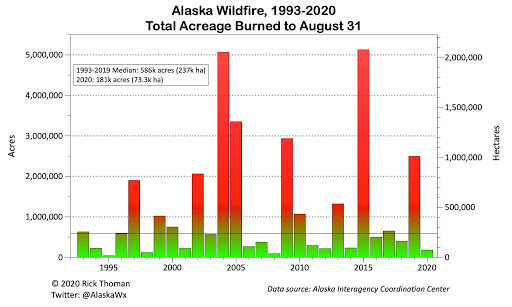Last week reader Carl asked about humidity this summer in Fairbanks and suggested correctly that dry days were unusually absent. This is an interesting point, so I created a chart to illustrate my earlier brief response: that the summer's lowest daily-mean humidity was higher than in any other summer in recent decades. This is true both for relative humidity and dewpoint; there were only 3 days with (midnight-to-midnight) average relative humidity below 50%, and only 3 days with average dewpoint below 40°F.
Here's a more focused visualization of how this summer's relative humidity differed from the typical distribution of the past 20 years (click to enlarge).
As Carl noted, the lack of very dry days was notable, and correspondingly the number of days with 70-80% relative humidity was higher than normal. Of course there is nearly always a marked increase in relative humidity as summer advances in Fairbanks, so the driest days are nearly all confined to June and early July, but nevertheless the chart gives a broad sense of the unusual shortfall in dry days this year.
A rather obvious point to make is that low humidity strongly favors growth of wildfires, and so the absence of dry conditions this year is presumably one of the main reasons for the very low fire acreage. Here's a superb fire acreage chart that Rick Thoman posted the other day.
Finally, while relative humidity was clearly well above normal this summer, dewpoint and atmospheric column-total moisture (precipitable water) were not as high as in some recent years. Here's an update on a chart I showed back in 2017, when July humidity was extraordinarily high. The upward linear trends since 1980 are statistically significant (p=0.05) for dewpoint in all three summer months, but interestingly not for precipitable water.




No comments:
Post a Comment